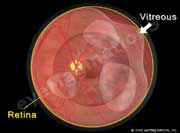|
Aging Changes in the Eye
Play Streaming Video Clip
56K
| 100K
 |
Vitreous Detachment
Aging
causes the vitreous gel to become less like a gel and more
like a fluid. As the eye moves, liquefied vitreous also move
around inside the vitreous cavity. This movement causes the
vitreous to pull on the retina, and in time the vitreous can
pull free and separate from the retina. This is called a
posterior vitreous detachment. Pulling of the vitreous on the
retina can cause flashes of light. We usually see this once a
posterior vitreous detachment occurs. As the vitreous
liquefies and pulls away from the retina it becomes condensed
and stringy and forms strands. We see these strands and
strings as they appear as spots, circles, jagged lines and
irregular fine threads in the vision. They appear to float,
and we call these vitreous floaters.
|
For more video clips, click the links below...
As with all of our bodily functions, the performance of the visual system declines with age. The most common age related change in the eyes is cataract. Everyone WILL develop these if you are around long enough, some sooner than others, but usually these don't have to be addressed until our late 70's and early 80's. The internal lens continues to thicken, and eventually it is so thick that it gets a little hazy. It is like looking through a dirty window or through a waterfall, hence the name. Fortunately, cataract operations are relatively simple and non-invasive these days.
Another all too frequent disorder of aging is macular degeneration. You can think of this as "hardening of the arteries in the eyes". The macula is the part of the retina you use when you look directly at something, and in order to get that fine resolution, it is also the thinnest part. Unfortunately, this makes it most susceptible to breakdown in the fine circulation in the retinae, and once the cells are deprived of nourishment, they begin to die off. Only rarely is this reversible, and it is not treatable in around 90% of patients..
Less frequent but not uncommon is glaucoma, a nerve disease of the eye. Glaucoma means "loss of peripheral vision" and if not treated, may progress to central vision and hence to blindness. Usually, this is asymptomatic - you can lose almost 3/4 of your side vision before it becomes functionally apparent, or before you notice it. This is why early detection is imperative. In our office, we have an automated perimeter or computer controlled side vision tester, which will pick up early glaucoma long before it becomes a problem. Treatment is usually eye drops to control intra-ocular pressures.
 |




